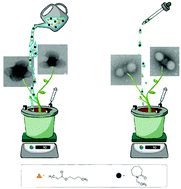Multilobular morphology: the key for biphase multifunctional nanogels†
Abstract
Nanogels play a leading role in controlled release systems because they possess high water retention capacity resulting in high loading capabilities, stability in biological fluids and biocompatibility. In this scenario, every tool that allows extending the nanogel properties and expanding their potential applications is of high interest in the field of biomedicine. This article aims to contribute to the development of multifunctional nanogels, based on the combination of two polymer phases in a multilobular morphology. The synthesized multilobed nanogels (mLNGs) presented a core of crosslinked poly(N-vinylcaprolactam) (PVCL) and a shell formed by 3-D distributed lobes of a low Tg copolymer. This particular multilobular morphology is able to exploit the synergetic contribution of both phases. While the PVCL-based core conferred its characteristic thermal response and the ability to load and release a cargo molecule, the low Tg lobes incorporated the capability of film formation. Moreover, the multilobular arrangement of NGs allows films to undergo unrestricted mass transfer. The development of mLNG morphology and the effect of synthesis parameters were deeply studied with the help of a previously developed mathematical model for the dynamic evolution of particle morphology. Finally, this study presents, for the first time, the synthesis of two-phase nanogels with multilobular morphology and underlines their potential as a candidate for controlled delivery platforms.



 Please wait while we load your content...
Please wait while we load your content...